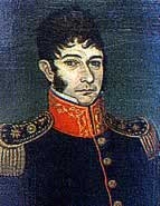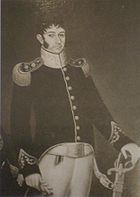
Nicolás Rodríguez Peña
Encyclopedia

Buenos Aires
Buenos Aires is the capital and largest city of Argentina, and the second-largest metropolitan area in South America, after São Paulo. It is located on the western shore of the estuary of the Río de la Plata, on the southeastern coast of the South American continent...
1775 – Santiago de Chile; 1853) was an Argentine politician
Argentina
Argentina , officially the Argentine Republic , is the second largest country in South America by land area, after Brazil. It is constituted as a federation of 23 provinces and an autonomous city, Buenos Aires...
. Born in Buenos Aires in April 1775, he worked in commerce which allowed him to amass a considerable fortune. Among his several successful businesses, he had a soap factory partnership with Hipólito Vieytes
Hipólito Vieytes
Juan Hipólito Vieytes, was an Argentine merchant and soldier. He was born in San Antonio de Areco, Buenos Aires Province on 6 August 1762, son of Juan Vieytes and Petrona Mora Fernández de Agüero...
, which was a center of conspirators during the revolution against Spanish
Spanish Empire
The Spanish Empire comprised territories and colonies administered directly by Spain in Europe, in America, Africa, Asia and Oceania. It originated during the Age of Exploration and was therefore one of the first global empires. At the time of Habsburgs, Spain reached the peak of its world power....
rule. In 1805 he was a member of the "Independence Lodge", a masonic lodge
Masonic Lodge
This article is about the Masonic term for a membership group. For buildings named Masonic Lodge, see Masonic Lodge A Masonic Lodge, often termed a Private Lodge or Constituent Lodge, is the basic organisation of Freemasonry...
, along with other prominent revolutionary patriots such as Juan José Castelli
Juan José Castelli
Juan José Castelli was an Argentine lawyer. He was one of the leaders of the May Revolution, which started the Argentine War of Independence...
and Manuel Belgrano
Manuel Belgrano
Manuel José Joaquín del Corazón de Jesús Belgrano , usually referred to as Manuel Belgrano, was an Argentine economist, lawyer, politician, and military leader. He took part in the Argentine Wars of Independence and created the Flag of Argentina...
. This group used to meet in his ranch, then situated in what today is Rodriguez Peña square in Buenos Aires.
He was a member of the local militia
Militia
The term militia is commonly used today to refer to a military force composed of ordinary citizens to provide defense, emergency law enforcement, or paramilitary service, in times of emergency without being paid a regular salary or committed to a fixed term of service. It is a polyseme with...
in the British invasions of the Río de la Plata
British invasions of the Río de la Plata
The British invasions of the Río de la Plata were a series of unsuccessful British attempts to seize control of the Spanish colonies located around the La Plata Basin in South America . The invasions took place between 1806 and 1807, as part of the Napoleonic Wars, when Spain was an ally of...
(1806 and 1807), and after taking part as promoter and financier of the May Revolution
May Revolution
The May Revolution was a week-long series of events that took place from May 18 to 25, 1810, in Buenos Aires, capital of the Viceroyalty of the Río de la Plata, a Spanish colony that included roughly the territories of present-day Argentina, Bolivia, Paraguay and Uruguay...
, he collaborated in the formation of the Primera Junta
Primera Junta
The Primera Junta or First Assembly is the most common name given to the first independent government of Argentina. It was created on 25 May 1810, as a result of the events of the May Revolution. The Junta initially had representatives from only Buenos Aires...
. Was secretary to Castelli, and went with him in the liberation army's expedition to Córdoba
Córdoba, Argentina
Córdoba is a city located near the geographical center of Argentina, in the foothills of the Sierras Chicas on the Suquía River, about northwest of Buenos Aires. It is the capital of Córdoba Province. Córdoba is the second-largest city in Argentina after the federal capital Buenos Aires, with...
, where he authorized the death by firing squad of the previous viceroy Santiago de Liniers
Santiago de Liniers
Jacques de Liniers was a French officer in the Spanish military service, and a viceroy of the Spanish colonies of the Viceroyalty of the Río de la Plata. He is more widely known by the Spanish form of his name, Santiago de Liniers...
. After fighting at the Battle of Suipacha
Battle of Suipacha
The Battle of Suipacha was fought on 7 November 1810 in Bolivia during the Bolivian War of Independence between the Spanish colonial army and the Republican forces sent by the Primera Junta from Buenos Aires. At the time Bolivia was known as Upper Peru . It was the first decisive defeat of the...
he entered Upper Peru
Upper Peru
Upper Peru was the region in the Viceroyalty of Peru, and after 1776, the Viceroyalty of the Río de la Plata, comprising the governorships of Potosí, La Paz, Cochabamba, Los Chiquitos, Moxos and Charcas...
, where he was for a short time governor of La Paz
La Paz
Nuestra Señora de La Paz is the administrative capital of Bolivia, as well as the departmental capital of the La Paz Department, and the second largest city in the country after Santa Cruz de la Sierra...
.

Mariano Moreno
Mariano Moreno was an Argentine lawyer, journalist, and politician. He played a decisive role in the Primera Junta, the first national government of Argentina, created after the May Revolution....
at the First Junta ("Primera Junta"). He was deposed by the revolution of April 1811 and confined to San Juan Province
San Juan Province (Argentina)
San Juan is a province of Argentina, located in the western part of the country. Neighbouring provinces are, moving clockwise from the north, La Rioja, San Luis and Mendoza. It borders with Chile at the west....
. Rodiguez Peña returned later the same year to Buenos Aires, returning to commerce once again. He joined the Logia Lautaro
Logia Lautaro
The Lautaro Lodge was a revolutionary secret lodge active in Latin American politics in the 19th Century. It was initially known as the Lodge of Rational Knights .Its initial purposes were to apply the goals of the Spanish Enlightenment, and when Spain began the Absolutist Restauration they...
, directed by Carlos María de Alvear
Carlos María de Alvear
Carlos María de Alvear was an Argentine soldier and statesman, Supreme Director of the United Provinces of the Río de la Plata in 1815....
. Due to the revolution of October 1812, he was elected member of the Second Triumvirate
Second Triumvirate (Argentina)
The Second Triumvirate was the governing body of the United Provinces of the Río de la Plata that followed the First Triumvirate in 1812, shortly after the May Revolution, and lasted 2 years....
, a government just created by the Constitutional Congress
Asamblea del Año XIII
The Assembly of Year XIII was a meeting called by the Second Triumvirate governing the young republic of the United Provinces of the Río de la Plata on October 1812....
.
When the Triumvirate was dissolved, the Supreme Director, Gervasio Antonio de Posadas
Gervasio Antonio de Posadas
Gervasio Antonio de Posadas y Dávila was a member of Argentina's Second Triumvirate from 19 August 1813 to 31 January 1814, after which he served as Supreme Director until 9 January 1815....
, selected him to preside the State Council ("Consejo de Estado"). He was also assigned as a colonel in the army. In 1814 he was named first governor delegate of the Eastern Province
Banda Oriental
The Banda Oriental del Uruguay was the South American territory east of the Uruguay River and north of the Río de la Plata, coinciding approximately with the modern nation of Uruguay, the Brazilian State of Rio Grande do Sul and some parts of Santa Catarina...
(present-day Uruguay
Uruguay
Uruguay ,officially the Oriental Republic of Uruguay,sometimes the Eastern Republic of Uruguay; ) is a country in the southeastern part of South America. It is home to some 3.5 million people, of whom 1.8 million live in the capital Montevideo and its metropolitan area...
), a post he held for only a short time.
After the fall of Director Alvear, he was charged, judged, and exiled, and was allowed to live in San Juan. In 1816 he went back to Buenos Aires, but the new Supreme Director, Juan Martín de Pueyrredón
Juan Martín de Pueyrredón
Juan Martín de Pueyrredón y O'Dogan was an Argentine general and politician of the early 19th century. He was appointed Supreme Director of the United Provinces of the Río de la Plata after the Argentine Declaration of Independence.-Early life:Pueyrredón was born in Buenos Aires, the fifth of...
, forced him to return to exile in San Juan where he helped José de San Martín
José de San Martín
José Francisco de San Martín, known simply as Don José de San Martín , was an Argentine general and the prime leader of the southern part of South America's successful struggle for independence from Spain.Born in Yapeyú, Corrientes , he left his mother country at the...
organize the Army of the Andes
Army of the Andes
The Army of the Andes was a military force created by the United Provinces of the Río de la Plata and mustered by general José de San Martín in his campaign to free Chile from the Spanish Empire...
for the crossing into Chile.
After the Battle of Chacabuco
Battle of Chacabuco
The Battle of Chacabuco, fought during the Chilean War of Independence, occurred on February 12, 1817. The Army of the Andes of the United Provinces of the Río de la Plata led by General Captain José de San Martín defeated the Spanish force led by Rafael Maroto...
he self-exiled himself in Santiago de Chile, where he remained until his death in December 1853. His remains were interred in La Recoleta Cemetery
La Recoleta Cemetery
La Recoleta Cemetery is a famous cemetery located in the exclusive Recoleta neighbourhood of Buenos Aires, Argentina. It contains the graves of notable people, including Eva Perón, Raúl Alfonsín, and several presidents of Argentina.- History :...
in Buenos Aires.

